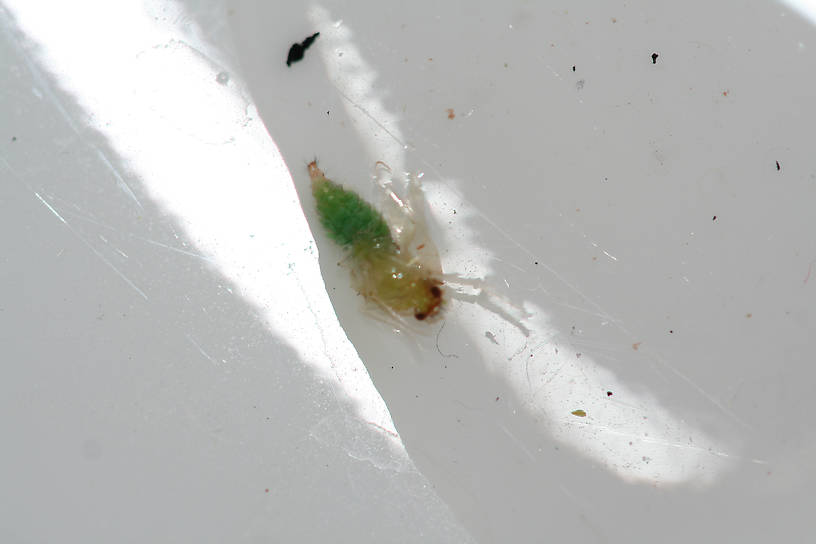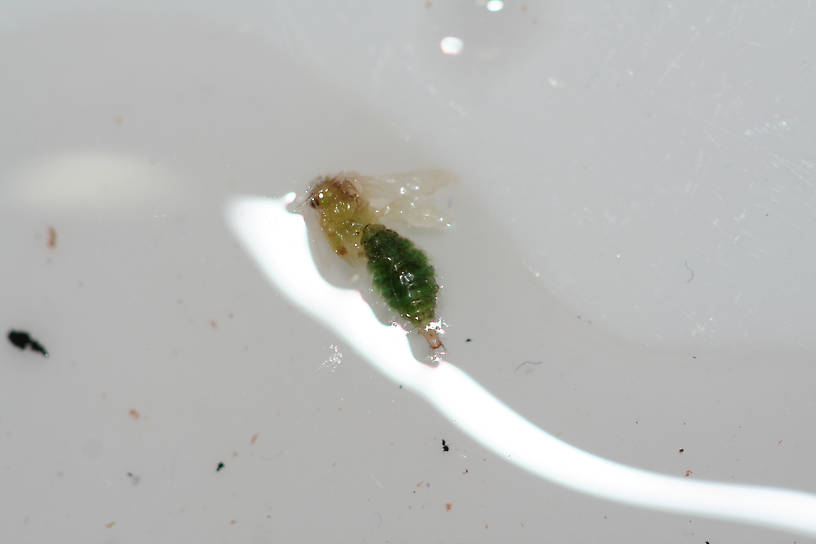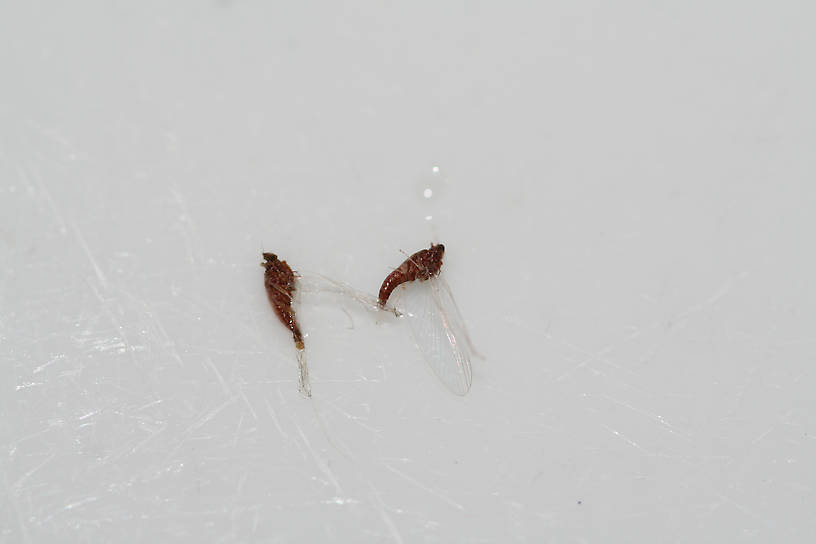Blog & Latest Updates
Fly Fishing Articles
Insects by Common Name


> > A few caddis and a baetid, Page 2
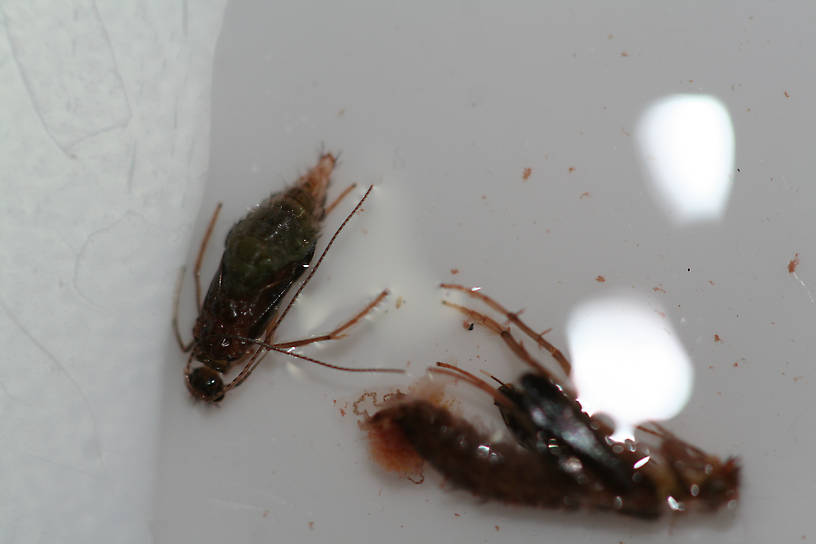
The smaller, more in-focus pupa was still alive, kicking and swimming, hours later while taking photos. The larger, blurry one died pretty quickly - I think I injured it. Size 16 and 12, respectively, nearly identical in color.
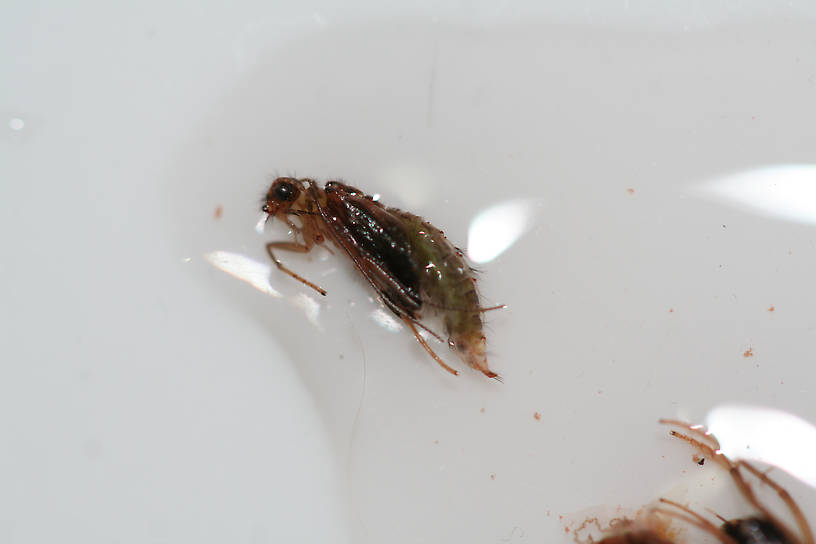
Side view of the smaller one. It didn't like to be flipped over - prefers right-side-up.
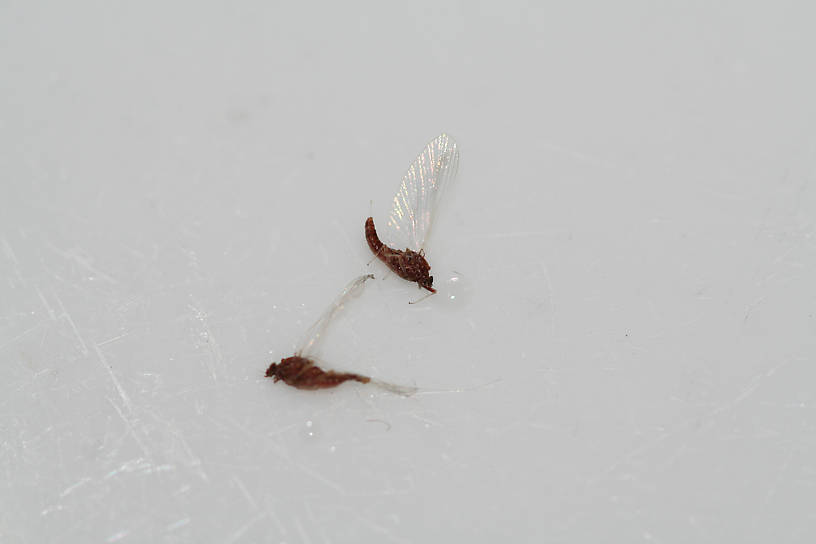
A few more of these little rusty baetids I've been finding. Don't know if the fish have been feeding on them - have only found them here and there. I tied up a few good-looking dries for them, but I haven't fished them yet. Size 24.
| Shawnny3 | July 28th, 2012, 12:22 am | |
Moderator Pleasant Gap, PAPosts: 1197 | Sorry for the delay, guys - been busy fishing. I seined it, but not in the drift. I was kicking around at some stones. If it came out of a case, though, it was without my knowledge - it was as you see it when I found it on the seine. -Shawn | |
| Jewelry-Quality Artistic Salmon Flies, by Shawn Davis www.davisflydesigns.com | ||
| PaulRoberts | July 28th, 2012, 12:05 pm | |
| Colorado Posts: 1776 | Hydro pupal cases are pretty fragile -easy to tear open -being fine gravel held with a small amount of "silk". Kick-sampling esp yields imm pupa for this reason. This is, in part, why I do most of my sampling, for fishing purposes, one cobble at a time -choosing one and then loosing it with net held below. I then observe what's clinging to the piece, before delving into the net. Targeting specific cobbles this way is generally less invasive, and more focused on micro-habitat. I do the same with specific sections of other substrates such as gravel, wood, etc. Shawn, this is NOT a critique of your sampling methods. It's just a general comment on accurate sampling that attempts to couple invert identification with associated micro-habitat and behavior. | |
| Creno | July 28th, 2012, 1:43 pm | |
| Grants Pass, OR Posts: 305 | Entoman - Perhaps a reader of this post may be able to recommend a fishing text that explains this in detail. Tom Ames (Caddisflies) has a good general discussion. your interpretation: "caddis pupa can have pale wings in the larval stage (the longest period) only getting darker as they progress through to the pharate stage in the last day or two, but that some species (particularly those known to drift for long periods at the surface prior to emergence) may stay pale and develop darker color as adults (as with some species of brachycentrid)." is not quite right. perhaps a typo to start? - pupae do not have larval stages. while I do not profess any expertise in insect development, here, briefly, is what I think is happening with caddis caddis: pupae, just like larvae and adults, develop and change over time. This time period can be thought of as around a couple weeks but, as I said before, it can be longer or shorter depending on a lot of factors, both genetic and environmental. Early in the pupal stage the wing pads are pale like in the images with this thread. The fact that the wing pads are slightly unfurled on the one specimen means they were disturbed during collection. This pupae is immature and cannot naturally emerge as an adult once out of the case. Just because the wing pads are spread out does not mean this specimen is beginning emergence. Pupae do not emerge. I don't remember my classwork but I don't think "pupae" have the muscles to accomplish emergence. later in the pupal stage the wing pads will darken up, even for those species with pale wings. They may not be black but they will be darker, even Nectopsyche. To be more correct the wing pads of the "pupae" are not getting dark. What you are seeing is the developing adult wings within the pupae. An adult is different than a pupae (e.g. is has a reproductive system), but the early adult development occurs within the pupal skin (and case). When you think about it it is a great, protective, evolutionary approach. late in the "pupal" development the pupae is actually "dead" and the adult is developing within the pupal skin and case. When the adult is ready to emerge it "separates" from the pupal skin but remains in the pupal skin. This separation is accomplished by the adult pushing gas between the adult cuticle and pupal cuticle. This stage is called a pharate adult. It is the stage that leaves the case and swims or crawls to the surface. Once the pharate adult (the adult in the pupal skin) separates itself from the pupal skin it is no longer a pharate adult. It is a teneral adult. It is paler than the final adult, and because parts like the wings and cuticle have not completely hardened I suspect the reproductive system is not viable yet either. (I have no knowledge about a correlation between coloration and duration of drift.) After a period of time, probably less than a day, the teneral adult hardens and becomes a reproductive adult with it's final coloration. Hydropsychid's are quite speciose and have many color patterns from pale tans and yellows with out much marking to highly patterned tan, brown and black taxa. hope this helps | |
| PaulRoberts | July 28th, 2012, 4:09 pm | |
| Colorado Posts: 1776 | This separation is accomplished by the adult pushing gas between the adult cuticle and pupal cuticle. Creno, are you sure it's gas -is that certain? Or is it a fluid? Very curious. | |
| Entoman | July 28th, 2012, 5:40 pm | |
| Northern CA & ID Posts: 2604 | Dave - Larval? Yes a typo. It's been fixed, thanks for pointing it out. BTW - thanks also for the detailed yet understandable explanations for the layman. You've helped make this a great thread! Shawn - A cool thing you can do with your son as he gets a little older/stronger is tag team the collecting. Have him stand upstream and pick up cobble or handfuls of detritus/weeds and gently rub or manipulate the objects under water in front of the net. You will collect more samples (they won't be missing as many legs and tails) and have a blast exploring with him.:) | |
| "It's not that I find fishing so important, it's just that I find all other endeavors of Man equally unimportant... And not nearly as much fun!" Robert Traver, Anatomy of a Fisherman | ||
| Shawnny3 | July 31st, 2012, 3:38 pm | |
Moderator Pleasant Gap, PAPosts: 1197 | Hey, Mack. I'm not sure I understand everything you're getting at, but I find it hard to believe that common (that is, relatively small) changes in air pressure would influence in a significant way an insect's ability to fly. If you transplanted a lowland insect to Denver, for example, I doubt it would be incapacitated by the change. Barometric changes might signal to the insect a likely shift in weather which might cause it to respond in a certain way different from normal (like not flying around as much, perhaps), but the idea that its wings can't push against the thinner air doesn't seem possible to me. High pressure and low pressure systems typically differ by tiny degrees. I just looked up the highest and lowest air pressures ever recorded, and they differ by 20%. Average changes are in the range of single percentage points. Also, I would bet against hydrogen being a gas created by the insect internally without very strong evidence to support it. CO2, O2, or even just air, seem much more likely to me. I suppose H2 is theoretically possible, but I doubt it's what is responsible. Perhaps the bug guys know for sure. -Shawn | |
| Jewelry-Quality Artistic Salmon Flies, by Shawn Davis www.davisflydesigns.com | ||
| Creno | July 31st, 2012, 10:11 pm | |
| Grants Pass, OR Posts: 305 | Paul - your Q on liquid vs gas is a good one - I don't know. In the preserved material I see as well as a couple times I have watched it happen in caddis it appears to me to be a gas - very reflective/shiny. But I don't know. I have now gone and found Snodgrass 1935 - see page 65-68. He says the general consensus is a fluid. and see http://insects.tamu.edu/students/undergrad/ento306/Resources/Lecture%204%20%28Integument%29%20%28sml%20sld%29.pdf. It shows a fluid leaving behind some kind of cavity. Sorry I cannot be of much help on this. creno | |
| Shawnny3 | July 31st, 2012, 10:54 pm | |
Moderator Pleasant Gap, PAPosts: 1197 | If a cavity is formed, isn't it possible that it is not a gas at all but a vacuum created by moving a fluid from its old location to a new one? If the insect is able to increase its volume while its mass remains constant, it would lower the overall density of the insect, helping it rise through the water column. -Shawn | |
| Jewelry-Quality Artistic Salmon Flies, by Shawn Davis www.davisflydesigns.com | ||
| PaulRoberts | July 31st, 2012, 11:21 pm | |
| Colorado Posts: 1776 | Dave, thanks for looking into that. The question is an interesting one, since most people have taken Gary Lafontaine's statements that it is a gas. The link you provide is broken. Would love to see it. Shawn, now that's a neat idea. A fluid that expands via a catalyst? How else could it be done? | |
| Shawnny3 | August 1st, 2012, 1:01 am | |
Moderator Pleasant Gap, PAPosts: 1197 | I'm thinking of a mechanism like a fish's swim bladder. Now, I suppose the bladder is filled with a mixture of gases, but it is not the quantity of gas forced into or out of the bladder that causes it to expand or contract, rather it is the action of muscles surrounding it that increase or decrease the volume of the existing gas. As the volume of the bladder is increased, the fish floats, and as it decreases, it sinks - like a Cartesian diver. I just wonder if the insect creates cavities by shifting things around internally, causing a net increase in its volume and hence a lower density, without the need to pump itself up like a bike tire. Just pure speculation - like most of what I have to say. -Shawn | |
| Jewelry-Quality Artistic Salmon Flies, by Shawn Davis www.davisflydesigns.com | ||
| Falsifly | August 1st, 2012, 10:14 am | |
| Hayward, WI. Posts: 661 | The link you provide is broken. Creno's link | |
| Falsifly When asked what I just caught that monster on I showed him. He put on his magnifiers and said, "I can't believe they can see that." | ||
| PaulRoberts | August 1st, 2012, 10:30 am | |
| Colorado Posts: 1776 | Shawn, Problem is, gasses are compressible, but fluids? Water, at least, isn't. How about lipids? Hmmm..volume increase, how might it be done? Simply growth within the pupal case? Stored materials in the last instar used to develop the pupa and also expand its volume? Could it be purely the shape change from something long and thin (larval shape) to the more compact pupal shape? Would this be enough to alter buoyancy? In one of my threads about the eclectic mix of insects recovered fro a trout stomach, I noticed that only the midge pupae floated in the dish. All other forms were larvae and they were all at the bottom of the dish. I could see no sign of gas or anything beneath the exuvia. Thanks for the link, Alan. From Creno's link it appears dermal glands secrete "molting fluid" to begin the process. Presumably that's present when the adult steps out of the pupal skin. There is also a period of "wax production" mentioned that begins just prior to ecdysis (molting). Would like to sit in on that lecture. Here's a previous thread that includes Ralph Cutter's direct response and a link to Gary Borger's treatment of the subject. http://www.troutnut.com/topic/2516/Caddis-Pupae-Question | |
| GONZO | August 1st, 2012, 11:39 am | |
Site Editor "Bear Swamp," PAPosts: 1681 | Just a few thoughts about the fluid vs. gas thing: This is just conjecture on my part, but is it possible that part of the problem in answering this question is that both could be involved in different parts of the process? During the process of molting, insects secrete molting fluid, and that fluid fills the space between the old cuticle and the developing new one. That would seem to be the answer, but in a paper about the mayfly subimago, Edmunds and McCafferty (1988) say this about mayfly nymphs just prior to the molt to the subimago: A gaseous layer that forms between the larval cuticle and the pharate subimago provides buoyancy and is evidenced by several small extruding bubbles. Perhaps the missing connection is that (in most accounts that I have read) the molting fluid is resorbed sometime prior to the shedding of the old cuticle. One account (of a species of moth, as I recall) mentioned that successful shedding of the old cuticle (ecdysis) was usually not accomplished if this resorption was prevented. Other accounts suggest additional ways that various arthropods use gas or fluid pressures in the shedding of the old cuticle. Increases in volume of the gut (accomplished by "gulping air") or increases in blood (hemolymph) pressure are also mentioned as possible methods that assist in bursting the old cuticle. (The former method can apparently also play some role in mayfly oviposition, perhaps by assisting in the complete evacuation of the oviducts, or in the extreme case of at least one parthenogenetic mayfly, by bursting the abdomen of the female subimago to extrude eggs. See Funk 2008.) Although I haven't found an account precisely describing this or the process by which it is accomplished, might it be possible that (in some aquatic insects) the space between the old and new cuticle is filled with gas after (or as?) the molting fluid was resorbed? If so, the answer to whether that space is filled with fluid or gas would depend on where the insect was in the process between separation (apolysis) and shedding (ecdysis). Konchu, any thoughts on this? | |
| Creno | August 1st, 2012, 12:22 pm | |
| Grants Pass, OR Posts: 305 | Gonzo et al. - while obviously I don't know the answer, we have to remember caddis are holometabolous while mayflies are hemimetaboulous. While they are all insects I suspect we have to be pretty careful when drawing corollaries amongst them. Also, caddis are doing some/most of this underwater, which would seem to me to be a much different set of conditions than terrestrial leps. I will ask a couple trichopterologists with alot more training/experience than I to see what they say. | |
| PaulRoberts | August 1st, 2012, 1:26 pm | |
| Colorado Posts: 1776 | I agree one does not have to exclude the other. Creno, that would be great. Hopefully the work has already been done somewhere. If not, I guess the angling world we must wait for a funded grad student to go there. I remember there has been some research along these lines out of the UK, but do not have it. | |
| Entoman | August 1st, 2012, 2:22 pm | |
| Northern CA & ID Posts: 2604 | Interesting... My suspicion is that the idea of gases being used to separate the pupal cuticle from the pharate adult "making them look shiny" is similar to the idea that mayfly duns "dry their wings" in that both seem to be passed on in angling lit without factual basis. Just finished a marathon drive to Idaho for 10 (or more) days of fishing, so I don't have access to my library and only my phone to work with, but I seem to remember we discussed this in a thread regarding the shiny look of submerged caddis and the difference between adult egg layers and pupae in this regard. I can say anecdotally that the pupae (pharates) I've captured over the years don't look to have any shiny gas involved and are fairly neutral in boyancy, relying more on swimming action and use of the meniscus than anything else. They usually do have a translucent glow about them, which I attribute to light filtering through the gap created by the molting fluid and the cellophane like look of the pupal cuticle. Hence, my love affair with using antron in some form on most of my pupal imitations.:) | |
| "It's not that I find fishing so important, it's just that I find all other endeavors of Man equally unimportant... And not nearly as much fun!" Robert Traver, Anatomy of a Fisherman | ||
| PaulRoberts | August 1st, 2012, 2:43 pm | |
| Colorado Posts: 1776 | Kurt, I lean that way too. That said, you and I need to shut up and go fishing! I'm trying to get out the door on what was to be an overnight along a remote stream section, now getting whittled down to an afternoon along a more accessible stretch. The longer I stay home ... the longer I stay home. (It has less to do with this site than all that other stuff...). I'm turning OFF my computer now. Wish me luck, and bliss. | |
| Entoman | August 1st, 2012, 2:44 pm | |
| Northern CA & ID Posts: 2604 | Ha! On my way as I write this (I'm not driving).:) | |
| "It's not that I find fishing so important, it's just that I find all other endeavors of Man equally unimportant... And not nearly as much fun!" Robert Traver, Anatomy of a Fisherman | ||
| PaulRoberts | August 1st, 2012, 3:15 pm | |
| Colorado Posts: 1776 | Good luck. Enjoy. | |
| GONZO | August 1st, 2012, 9:39 pm | |
Site Editor "Bear Swamp," PAPosts: 1681 | Creno et al. After work, I had the opportunity to search for the paper that discussed the resorption of the molting fluid prior to ecdysis (in a moth). That paper was "Modulation of foregut synaptic activity controls resorption of molting fluid during larval molts of the moth Manduca sexta" by Jennifer E. Bestman and Ronald Booker (2003). The full text of the paper can be found here: http://jeb.biologists.org/content/206/7/1207.full.pdf Creno's cautions about suggesting correlations between mayflies and caddisflies or terrestrial moths and aquatic caddisflies are appropriate and appreciated, but some information in this paper would seem to support the possibility of what I was suggesting (and in a similar holometabolous insect, though still a terrestrial one). A few additional provisos: The paper discusses a larval-to-larval molt, and of course, it only applies with any degree of certainty to the insect studied. However, one statement says that at least the resorption/removal of the molting fluid (MF) is common to all: The secretion of MF and its resorption many hours later are among a series of molt-related events that must be precisely coordinated during the molt cycle. While the removal of the MF prior to ecdysis is a feature common to all insect molts, there is no consensus on the mechanisms used to remove the MF from the exuvial space. As for my suggestion that perhaps the molting fluid might be replaced by a gas, apparently that can occur, in at least this instance. In addition to MF (molting fluid), HCS is used in the excerpt below for "head capsule slippage" (an event that the authors used as a signal that the molting process had begun): At 21.2±0.2 h after HCS (N=95), air bubbles collected in the old head capsule, indicating that MF had begun to be removed from the exuvial space. Over the next 4 h, air continued to fill the exuvial space, and the old cuticle dried slightly. At 25.2±0.2 h after HCS (N=67), the molt cycle ended when the animal shed its old cuticle during ecdysis. So, it would seem that a gas (air) replacing the molting fluid and filling the exuvial space prior to ecdysis is possible and documented in (at least) this case. | |
Quick Reply
You have to be logged in to post on the forum. It's this easy:
Related Discussions
| Title | Replies | Last Reply |
| Re: Hydropsychid? In Hydropsyche Caddisfly Pupa by GONZO | 14 | May 7, 2009 by LittleJ |
| Re: Live Chimarra pupae In the Identify This! Board by Millcreek | 13 | Oct 2, 2014 by Millcreek |
| Re: Caddis Pupae Question In the Insect Order Trichoptera by PaulRoberts | 40 | Nov 23, 2015 by Martinlf |
| Re: caddis pupa In General Discussion by LittleJ | 3 | May 16, 2010 by Creno |
| Re: Pupal exuvia pics In the Photography Board by Creno | 7 | Aug 5, 2012 by PaulRoberts |
| Several new specimens In General Discussion by Troutnut | 0 | |
| Re: Pupa color? In the Caddisfly Genus Chimarra by Frankcoz | 6 | Apr 5, 2012 by Entoman |
| Re: La Fontaine Caddis patterns In General Discussion by Goose | 3 | Oct 19, 2006 by GONZO |
| Re: another caddis question In General Discussion by Goose | 12 | Oct 21, 2006 by GONZO |
| Green Sedge In the Identify This! Board by Wiflyfisher | 0 |
Troutnut.com is copyright © 2004-2024 Jason
Neuswanger (email Jason). See my FAQ for information about use of my images.
 privacy policy
privacy policy

